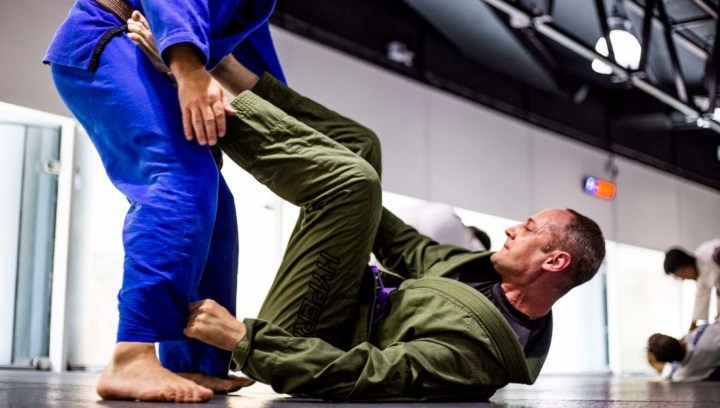Guest post by Evolve MMA, Asia’s premier championship brand for martial arts. It has the most number of World Champions on the planet. Named as the #1 ranked martial arts organization in Asia by CNN, Yahoo! Sports, FOX Sports, Evolve MMA is the top rated BJJ gym in Singapore.
One of the most difficult skills to develop in Brazilian Jiu-Jitsu (BJJ) is playing guard against a standing opponent. Along with having the benefit of top position, the opponent’s decision to stand gives him a speed advantage that can lead him to simply run around your guard. While this can be incredibly frustrating, it would be a mistake to abandon attempting to play open guard against standing opponents just because it is difficult at first. By choosing to stand, your opponent has given up access to his lower body, allowing you to utilize several different guards to off balance and eventually sweep or submit him. Take a look at our guide to open guards against standing opponents, and make sure you practice your favorites regularly!
1) Single Leg X-Guard
Single Leg X-Guard, or SLX as it’s commonly referred to, is currently one of the most popular positions in Brazilian Jiu-Jitsu and No-Gi Grappling. While the position has existed for quite some time, it wasn’t until the recent focus on attacking leg locks that SLX became such a popular choice for playing guard against standing passers.
Like most of the moves in Brazilian Jiu-Jitsu, the position we recognize as Single Leg X-Guard originated from classic Judo. Although the modern Judo ruleset makes the position virtually illegal and completely useless, it is an incredibly effective guard for both sweeping and submitting opponents under a less restrictive ruleset. The legendary grappler Marcelo Garcia made extensive use of the position during his record-breaking competition career. While Mr. Garcia used SLX almost exclusively for sweeping his opponents, current competitors such as Eddie Cummings have built off of Marcelo’s success and adapted the guard to attack lower body submissions, particularly heel hooks. Often when focusing on submissions you will hear SLX referred to as “Ashi Garami,” a Japanese translation of “leg entanglement.”
Along with offering a plethora of sweep and submission options, the Single Leg X-Guard owes its popularity to the relative ease of obtaining it, especially against a standing opponent. While other guards may require obtaining a combination of hard-to-get grips, SLX does not. All that needs to be done to enter the position is to move your shin in front of your opponent’s as he steps into your seated guard. From here, a simple maneuver of falling back and kicking your leg straight will place you in a perfect Single Leg X Guard. Now you have all the sweep options of Marcelo Garcia, as well as all the submission options of Eddie Cummings. This is an incredibly powerful combination that would provide troublesome for even the most experienced guard passer to defeat.
2) De La Riva Guard
While the Single Leg X Guard seems to have become extremely popular in the past few years, the De La Riva Guard (DLR) has long been one of the most common guards utilized against a standing opponent. As mentioned above, a great number of the positions and guards found in Brazillian Jiu Jitsu originated from a previous form of Judo. That does not seem to be the case for the De La Riva Guard, as all credit for the development and systemization of the position is given to the man the guard is named after, Ricardo De La Riva.
De La Riva developed his guard while he was training at Carlson Gracie’s school in Brazil. The Carlson Gracie Academy is an incredibly prestigious school known for its ferocious style of guard passing. In order to keep up with the bigger Vale Tudo fighters who excelled at guard passing, the smaller and more flexible De La Riva developed the De La Riva Guard to help slow down more athletic opponents and give him a chance to set up his attacks.
While the Brazilian Jiu-Jitsu game has changed a lot since De La Riva first started developing this guard system, the need for smaller players to be able to slow down more explosive players is still very much prevalent. Fortunately for those players, DLR is still an incredibly effective tool for countering a standing passer who has an athletic and size advantage. By establishing the powerful De La Riva hook you have taken the first step to negate your opponent’s strength and explosiveness. Once the hook is established there are a plethora of gripping options to set up sweeps and submissions. While the majority of the guard is played with sleeve and collar grips, it should be noted that De La Riva is still incredibly effective in No-Gi grappling as the power of the leg hook is still present. If you feel as if standing opponents are constantly running around your guard, De La Riva is an excellent option to slow them down and give you plenty of chances to attack.
3) Spider Guard
Perhaps no guard is more frustrating to pass than a properly executed Spider Guard. While there are many guards that are difficult to pass, including the two previously mentioned, none create the feeling of complete hopelessness for the passer that Spider Guard does. Spider Guard is initiated by grabbing the sleeves of your opponent, then placing your feet on his biceps. By extending and contracting your legs, your opponent’s upper body will be completely immobilized, leaving only his lower body to defend.
It is difficult to describe just how pathetic one feels when they are being attacked by a good Spider Guard player, but the analogy of a marionette doll comes close. Control of the passer’s arms is essentially taken away from them, leaving them only their lower body to break the grips and pass. This creates ample opportunities for sweeps and submissions as they will have to take their legs off of the ground in order to kick out of your powerful grips.
Along with plenty of sweeps, Spider Guard provides the opportunity to enter into triangles, armbars, and leg locks, so make sure you practice it plenty if you would like to have an aggressive open guard game.
It can be quite daunting to play guard against a standing opponent for beginners and veterans alike. The feeling as if you are starting from behind is not a pleasant one, but if you practice the three guards detailed above you will be finding success from the bottom in no time.



















